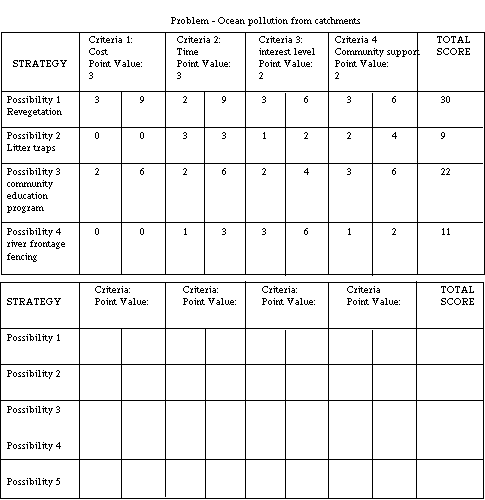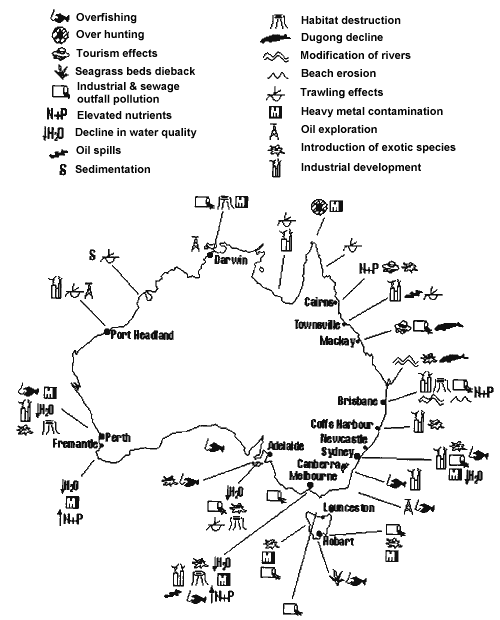Module 15 |
|
|||||||||||||||||||
|
Taking Action for the Coastal
|
|
|||||||||||||||||||
|
Resources |
|||||||||||||||||||
Resource 5
Teacher Guide to Setting Up an Edu - Action Project
Choosing a Project
At the stage you are ready to consider a project your students should be aware of some of the major issues affecting the local, regional or global Coastal and Marine Environment.
- Divide students into groups that work together well. Give each student
group a copy of any data that has been collected by the class, as well
as the results of any surveys about peoples opinions, in relation to
the issue that the class wishes to address to improve the local Coastal
and Marine Environment.
- Have each group of students brainstorm to identify a Range of Projects
that might address different aspects of the issue. When each group has
finished brainstorming projects, combine the lists into a class list.
- Facilitate the brainstorming of a list of Criteria for a Good Project. Possible criteria include (but are not limited to) the following:
- Cost: How much will the project cost? Can the money be raised through fundraising activities, grants, or donations?
- Time: How much time will the project take? Is it the right time
of year for the project?
- Interest: How much fun, how interesting, or how educational is the
project? Do you want to do it?
- Benefits: Who or what will benefit from the project?
- Participation: Can the entire class participate in this project?
- Community Involvement: Can the project involve people in your community?
- Support: Will you receive support from your school, the community,
and the rest of your watershed?
- Permission: Do you need permission to do parts of this project?
Will it be possible to get permission?
- Longevity: Will the project have a sustained benefit or a short-term effect?
- Have students fill out a “Project Investigation” worksheet
for the project of their choice. Students will probably be able to describe
projects in general without extra work, but encourage them to make phone
calls, conduct interviews, and conduct research if time allows. Have
students list each of the criteria established as those needed for a
successful project and rate their proposal against each.
- Allow each group to present their project persuasively to the class
in the form of a Public Service Announcement.
- Use a full class “Decision Making Matrix” to make your final decision. List your criteria across the top and your project possibilities down the side. Decide how well each possibility fits each criteria to choose a project that is right for your class.
Resource 6
Sample Decision Making Matrix
- Decide how important each criteria is, on a scale of 1 to 3. If a criteria is extremely important to your decision, it receives a 3; if it is not very important, it receives a 1. If the criteria is somewhere in between, it receives a 2. Write that number under the words “Point Value” in each column.
- Determine the extent to which each project possibility meets the criteria you chose. Score on a scale of 0 through 3 (0 - does not meet the criteria at all, 3 - meets the criteria perfectly). Write that number in the left half of the box.
- Multiply the criteria scores by the possibility scores to determine which possibility has the highest total points. Write each score in the right half of the box. Then add them to find the total scores.
Example:
Problem - Ocean pollution from catchments

Resource 7
Edu-action Project Goals
Ideally, Edu-action projects allow students to apply academic and interpersonal
skills to their community, continue their individual growth, and become
active citizens.
The goals for best practice in such projects should be
1. Meet a recognised need in the community
2. Achieve curricular objectives through projects participation
3. Reflect throughout education and action
4. Develop student responsibility
5. Establish community partnerships
6. Plan ahead for other projects
7. Equip students with knowledge and skills needed for service to the community
EDU-ACTION programs are directly relevant to meeting the Learning Outcome statements from the National Profiles for Studies of Society and Environment, in the Strand “Place and Space”. These statements concern projects that deal with caring for places.
To achieve these outcomes in planning for Edu-action a format for development of the unit(s) should include:
• Preparation
• Action
• Reflection
The following general guidelines may enhance the projects undertaken to ensure they achieve both educational and environmental outcomes.
Preparation
Your preparation begins as soon as your class starts your unit on studying the Coastal and Marine Environment. Simply by learning about the issues your project will address, your students will gain the knowledge and skills they need to complete a project. As part of this preparation, help your students understand the connection between their Project Goals and issues they have studied. The remaining preparation is mainly scheduling activities, recruiting participants, gathering materials, receiving permission, and finding funding.
1. Divide your students into committees responsible for different aspects
of preparation. Possible committees include:
• Information Committee responsible for finding the answers to questions about the project by contacting experts and conducting research
• Publicity Committee: publicises your project to the school, community, and region through the newspaper, radio and television; schedules visits from reporters
• Fundraising Committee: writes grants, solicits donations, or thinks of other ways to raise the necessary funds
• Permission Committee: seeks permission for all aspects of the work eg: land managers permission, seed collection permit, etc..
• Materials Committee: figures out what materials are needed and where they can be found. This job may include assisting the funding committee by asking businesses for donations of materials
• Building Committee: constructs necessary items with the materials collected by the materials committee eg:
• Reflection and Celebration Committee: plans ways for your class to reflect upon and celebrate the completion of your project
2. Develop a suggested time frame for the project. Many of these projects,
particularly those involving rearing and release of animals, need to be
done at a certain time of the year and follow a specific timetable.
3. Help your students come up with a detailed plan of action. As part
of their preparation, ask students to predict the outcome of their project:
What will the project accomplish? How will the community react? Will the
project be difficult or easy to implement?
4. Writing a grant application if support can be identified will give students important experience in real-world skills and empower them to take responsibility for every aspect of their project.
Action
1. During the action phase of the project, students will perform the service as planned and make adjustments as they gather new information and encounter new circumstances.
2. Most projects will require committees during the action segment, as well as during preparation.
Reflection
Reflection provides the means through which students can filter their
edu-action learning experience. Without a strong reflection component,
it is unlikely that students will recognise the significant connection
between the transient experience of their project and the broader context
of their lives.
Individual reflection activities allow students to analyse the personal
impact of their experience. Group reflection activities inspire students
to learn from other and from their experiences.
A list of general reflection ideas follows:
- Evaluate the outcome: Have students compare their predictions for what the project would accomplish to the actual outcomes of the project. This will allow them to analyse the evolution of the project and their perception of it. They may consider questions such as: Was this project more or less interesting, fun, and educational than we expected? What unexpected problems did we encounter? How did we overcome these problems?.
- Personal Reflection: Encourage your students to write journal entries throughout the service project as a tool for on-going reflection. You can guide their entries or allow them to write whatever comes to mind. Suggested entries include: first impressions, best and worst experiences, a friendship that developed during the project, a conflict and how it was resolved, an interesting observation.
- Evaluate Effectiveness: Students can discuss the effectiveness of their project in helping their regional species, in serving the community, and as a learning of experience. How could the project be improved?
- Reflect through action: Students can process their experience by sharing it! Meaningful possibilities include: writing to the local newspaper editor with a story; writing to their local, State or Federal politicians to voice an opinion or ask for a response; doing a public service announcement on the radio; or speaking at an assembly or community event. The Internet provides a forum for involvement with other groups that may be pursuing the same goals. These real-life applications challenge students to translate their experience into a form that they can share with others.
- Reflect by passing it on: Another great way for students to process their experience is by helping others to do the same project. Your students can write a handbook for other students who wish to do the same project, post their project on a web site, create an instructional video, start a newsletter, or do an on-site training for another class.
- Think Ahead: Students should consider the scope and longevity of their project. Do they need to involve others in order to sustain or expand the project? Where else could the project be conducted in the community, state, country, or world? What sort of follow-up does the project require?
- Reflect about Community Responsibility: Ask your students to think about their project as a contribution to the community. Did they become better citizens as a result conducting their project? What is the role of the citizen in making the community better?
Resource 8
Threats to Coastal and Marine Environments
|
Source: Our Sea, Our Future: Major Findings of the State of the Marine Environment Report for Australia, Department of the Environment, Sport and Territories, Canberra, 1995, pp. 72-78. |
